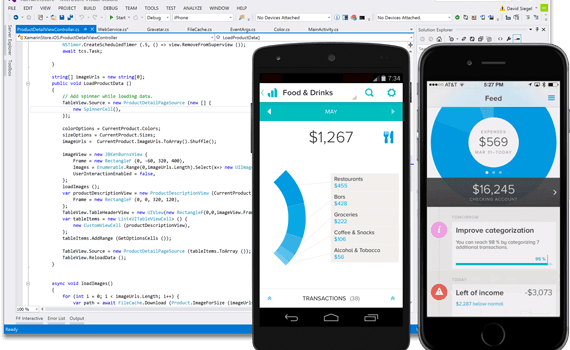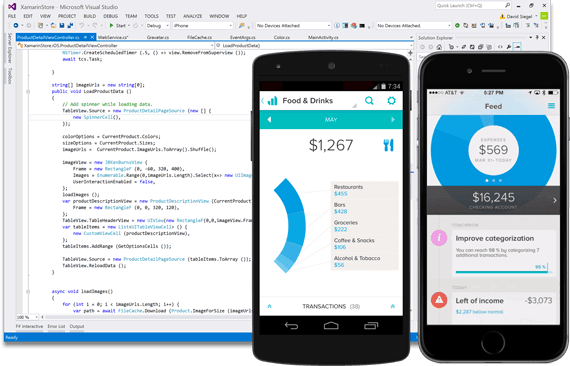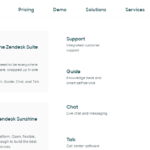Is Xamarin the Answer to Everything Mobile App Developers Ask for?
With an existing range of mobile platforms, developers are constantly in search for a toolset that can help them work with such platforms with little or no duplication of their labor. Instead of building an application for each separate system, they want their code shared across the main mobile platforms. And since recently, a growing number of such developers have been turning to Xamarin, one of the best-known tools for designing apps for different OSs, to solve that issue.
By using Xamarin, developers can create native apps for various platforms with shared C# codebase, language, APIs, and IDE. Xamarin shares approximately 75% of the application code across the mobile dev platforms and almost 100% when developing UI with Xamarin.Forms. It provides high efficiency and great UX on the basis of native API.
Since the solution’s inception, Xamarin and its tools have been warmly accepted by Microsoft-platform developers who wished to make use of their C# skills on Android and iOS, especially considering that Windows Phone has failed to become a great power on the mobile market so far.
With its Xamarin Platform, Xamarin.Forms, Xamarin Test Cloud, and its other popular products, Xamarin did resolve many challenges mobile app developers used to face. What developers love the most about it is its single, unified codebase they can use for cross-platform application building. By using such codebase, developers can save quite a lot of time and efforts.
Xamarin Platform bestows developers with numerous APIs, allowing them to create native applications for their intended devices from a single code base. To make sure that the unified codebase performs effectively, Xamarin Studio employs a debugging tool used live on a device or in a simulator mode.
The Platform delivers native mobile application development tools. By engaging Xamarin.iOS and Xamarin.Android, developers can build native iOS and Android applications with the help of C#, keeping complete Apple’s software development kit functionality and Google’s APIs.
Xamarin Platform integrates well with numerous application development tools, both proprietary and third-party, for more variable development environment. The Platform integrates with products provided by Microsoft, IBM, SAP, Amazon, Oracle, and many more. It grants access to various integrated customizations and extensions using its Xamarin Component Store.
Xamarin also supports cross-platform application development with its Xamarin.Forms, a toolkit allowing creation of native UI layouts with XAML or C#.
Xamarin Test Cloud serves as the company’s testing and automation software. It delivers functionality and performance testing of developed apps on over 1,800 devices and provides options to conduct tests on the basis of the OS, form factor, device manufacturer, and more.
Xamarin also quickly gained its popularity among developers thanks to its open-source nature that ensures flexibility, interoperability, and freedom of use. Xamarin is included into Visual Studio Community Edition that is free for individual developers, small teams, open-source and education projects, and academic research. Native apps for Android and iOS can be built in Visual Studio without any limitations on the size of an application.
Plus, when you consider its reusability, customizability, and other benefits described above, you are left with no questions why this .NET solution is so popular among developers all over the globe.
But keeping in mind all the undisputable benefits of the product, a developer should consider some of its drawbacks and limitations as well.
The main issue with Xamarin is its inability to handle some demanding visual aspects of user interface. There are visual editors that make work with UI much easier, but they do not have many of the original Android and iOS features, therefore development of a complex interface becomes quite challenging.
There are certain limitations affecting development, testing, and upload of an application to the store. The major limitation for iOS, for example, is that Xamarin does not have dynamic code generation support. It affects both compiled Xamarin code and the source code.
It has been noticed that applications created in Xamarin are comparatively larger and slightly slower than those built as native apps.
On the whole, despite the comparative newness of Xamarin, it still might and most likely will have a bright future. It is the most obvious choice for numerous projects. The platform enables to develop, test, and monitor applications that perform effectively due to the single code and architecture, delivering an attractive commercial value of applications for businesses.
Moreover, last year’s acquisition of Xamarin by Microsoft gives the platform a potential to become a milestone solution for any cross-platform development and indeed become the answer to everything mobile app developers ask for. Time will show.
About the author:
Eugene Rudenko is a senior online marketing manager for Oxagile, a bespoke software development company, with offices in New York and London. Oxagile offers web, mobile, front end development services and full-cycle development.
















